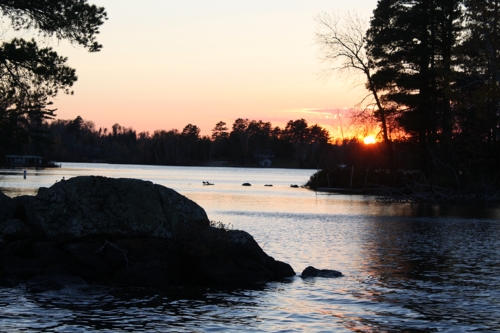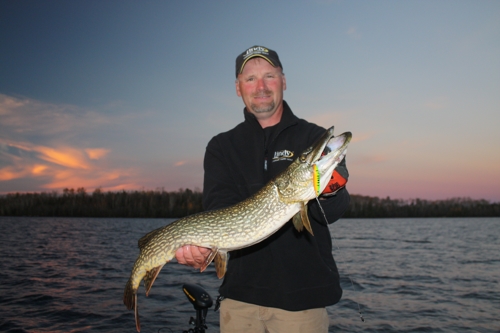Destination: Minnesota’s Lake Vermilion
Category: article
May 20th, 2011 by OutdoorsFIRST
Modified May 20th, 2011 at 12:00 AM
The channel that separates Ludlows Island from Lake Vermilion’s south shore isn’t terribly wide, but when you step aboard the classic wooden boat that shuttles guests to Ludlow’s Island Resort, you step into another world – a world strangely distant from modern day worries. A self-contained island resort with waterfront cabins connected by woodland trails, Ludlow’s has been operated by the Ludlow family for more than 70 years.
 |
|
|
|
Despite stretching over more than 40,000 acres, northern Minnesota’s Lake Vermilion seems intimate in most places because of the 365 islands and 1200 miles of shoreline that break up the lake’s clear but dark waters. It has the feel of a somewhat smaller Northwoods lake, but around every bend the lake just seems to keep going. Forests of birches and evergreens line rocky banks and cover most islands.
“Breathtaking Sunsets Included,” Ludlow’s boasts on their website, and the name Vermilion is a translation of the lake’s original Native American name, which spoke of glowing sunsets.
“We like to say it’s a Canadian experience, without the need to cross the border,” said Bill Rosner of Wild Country Guide Service.
Lake Vermilion isn’t just another pretty face, though. A tremendous amount of quality structure, vegetation beds and abundant forage equate to outstanding fishing for a variety of sportfish species, among them muskellunge, northern pike, walleyes, smallmouth bass, crappie and bluegill, and some of the best fishing occurs during the first part of the open-water season.
Muskies, which open June 4, are Lake Vermilion’s marquis gamefish. Stocked annually with extra-large-growing Leech-strain muskies and ultra rich with habitat and forage, Vermilion has developed into one of the world’s finest muskellunge lakes and annually produces some of the biggest fish caught anywhere.
“We’re probably a little spoiled,” Rosner said. “A 50-inch muskie is huge anywhere you catch it, but around here, no one gets that excited about a 50-inch fish.”
Rosner, a fourth-generation fishing guide, targets Lake Vermilion’s big muskies with a combination of trolling and casting strategies. Trolling an M/G Buck-A-Boo Muskie Spinner or M/G in-line spinner allows Rosner to cover a lot of water and can be highly effective for finding fish. However, he likes casting best, both because of the “hands-on” fun of working lures and feeling every strike and because this approach allows his clients to work individual weedbeds or other cover in the backs of the bays more thoroughly and to present lures over much shallower water.
 |
|
|
|
Early in the season, Vermilion’s big muskies and northern pike use many of the same shallow bays and eat a lot of the same foods as one another, so Rosner commonly catches the these big toothy fish together. Prior to the muskie opener he keeps his baits a little smaller and targets specific areas where he most commonly catches pike. Once muskie season opens, the muskies become his primary targets because that’s what many anglers have in mind when they travel to Lake Vermilion.
Rosner also spends a lot of time guiding anglers for walleyes during late May and June. The walleyes have finished spawning and often spend their days in deeper water. He’ll focus on the edges of structure, where rock gives way to sand or mud in 25 to 35 feet of water. Typically he will fish either with 3/8-ounce Lindy Jigs tipped with minnows or he will pull Lindy Rigs. As the season progresses, he’ll switch from minnows to leeches and night crawlers fished on the same rigs.
Toward evening, the walleyes will move shallow to feed atop points and bars that are close to the deeper water. When the fish move up, Rosner will target them with a Size 5 Lindy Shadling, which can be cast or trolled, and focuses mostly on structure that is 8 to 18 feet deep. His favorite Shadling colors are Perch and Tulibee.
Although Rosner doesn’t spend much time targeting them, Lake Vermilion also supports an outstanding population of smallmouth bass and decent numbers of big black crappie and various other panfish. Early in the year, these species all tend to be shallow and will relate to visible cover.
Ludlow’s Fishing
Ludlow’s Island Resort offers fishing/lodging packages that include a boat and 20 hp motor and fish cleaning, and some of the best fishing in the lake is within easy range of the island. The lake narrows substantially through the section that surrounds the island, creating a funneling effect for game fish on the move and providing great opportunities literally within sight of the boat dock. In fact, the main channel between the island and the lake’s south shore and a flat just up the lake produce a lot of really big muskies and pike.
Early in the season, many of the lake’s sport fish will be shallow, feeding over rocky points, along edges of cabbage beds and near other visible cover. Equipped with medium-sized spinning gear and a Shadling, Fuzz-E Grub or a Lindy Jig and a grub or live minnow, you’re apt to catch good numbers of chunky smallmouth bass and smaller pike and possibly some crappie or walleyes. It is fun fishing because you don’t have to know the lake well to find good action. Simply work the banks and cast to stuff that “looks fishy” and you’re apt to find more than ample reward.
Ludlow’s guests, both young and old, actually catch a lot of fish from the island’s shore and from the resort docks. Big live minnows produce pike and occasional muskies, while live worms and smaller artificial lures produce everything from smallmouth bass to sunfish.
Want to Go:
To get the latest word on the bite at Lake Vermilion, check out the Lindy National Audio Fishing Reports. To plan a trip with Bill Rosner, visit www.vermilionguide.com or give him a call at 218-666-2880.
To learn more about Ludlow’s Island Resort, visit www.ludlowsresort.com or call (877) LUDLOWS.